April Davila's Blog, page 30
October 25, 2019
California Cheese

 This post is part of an extended series I’m writing about California.
This post is part of an extended series I’m writing about California. You can find out more on my Why California page.
Northern California in the 1850s had a booming human population and very few dairy cows. Butter and cheese had to be shipped from Boston and New York at great expense. Inspired by the high prices, a few enterprising farmers imported dairy cows and the California cheese industry was born.
The cool temperatures and long grass-growing seasons of the northern coastal areas proved to be particularly bountiful for dairy owners. In Monterey, a businessman named David Jacks became the first to commercialize a soft white cheese that would gain popularity in the 1880s and come to be known as Monterey Jack.
Over time, that inventive spirit would become a hallmark of the California cheese industry. From Petaluma to Point Reyes, Northern California has more artisanal cheese producers than anywhere else in the country.
They continue to experiment with new flavors and styles, tinkering with mold-ripening and curd coagulation. From farmhouse cheddar to petit marcel there are over 250 distinct varieties available, a little something for cheesemonger and novice alike.
October 23, 2019
Goodreads Giveaway for 142 Ostriches


My publisher alerted me last week that they’ve set up a Goodreads giveaway for my book. They’re doling out 50 copies (!) so be sure to head on over to Goodreads and enter to win your free copy.
For me, this another in a long line of things that I am super excited to see happen on this journey of publishing my first book. It was even more exciting when I realized that people are actually entering this contest for my book. In fact, by the time I got the email from my publisher that the giveaway was live, over 500 people had entered to win a copy. As I write this, over 1300 people have entered.
Free Book
Now, as a fellow book junkie, I get it. I enter book giveaways all the time, because duh – free book, but there’s something a little different about seeing people toss their name in a hat to win MY book. I mean, I know the whole point of publishing is to let people read my book, and I always hoped people would want to, but to see it in action is really humbling.
There’s also been a huge uptick in people adding my book to their “Want To Read” list since the giveaway went live. So I guess the whole thing is doing what it’s supposed to – make people aware of the book. Can’t read a book you don’t know exists.
But again, to see all these people (who aren’t my mom – because my mom reads everything I write – hi mom!) set an intention to read my book is… well, it feels really special.
A Special Book
Because let’s be honest, there are a lot of things we can do in this world besides read. And of all the books in the world, that anyone would choose mine, it makes the book feel special. And since, in my mind, it’s been special for a long time, it feels somehow like I’ve entered a realm where my devotion is justified.
So thank you, thank you, thank you to everyone out there who has entered the giveaway, marked it as a “want to read” book, or gone ahead and pre-ordered it. It feels like I’m on this journey with you, and I am so grateful for the company.
October 22, 2019
Writing Tip Tuesday: Writing Pet Peeves Edition
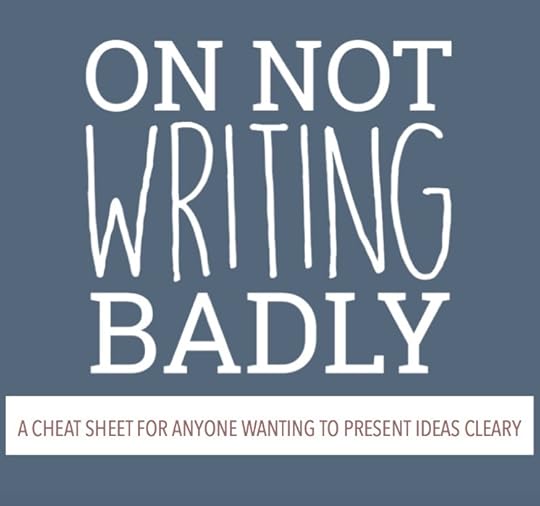
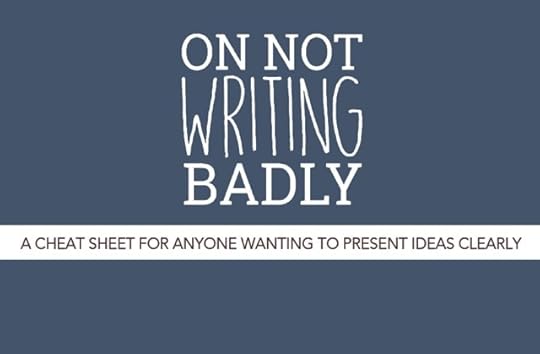 Welcome to the final Writing Tip Tuesday, the Writing Pet Peeves edition. If you’ve been following along, you know that I’ve been posting every Tuesday with content pulled from my free guide “On Not Writing Badly.” You can download the whole thing by simply filling out this form, or, if you’d rather not subscribe to my email list, you can simply scroll back through the last eleven Tuesdays for a super dose of word nerdery.
Welcome to the final Writing Tip Tuesday, the Writing Pet Peeves edition. If you’ve been following along, you know that I’ve been posting every Tuesday with content pulled from my free guide “On Not Writing Badly.” You can download the whole thing by simply filling out this form, or, if you’d rather not subscribe to my email list, you can simply scroll back through the last eleven Tuesdays for a super dose of word nerdery.
Having covered a lot of the basics, I thought I’d take a moment to share a few of the truly irritating things I see people do all the time in their writing.
So heregoes, in no particular order…
Writing Pet Peeves
“As per,” “could be said,” and “can be considered” are usually redundant. Cut them.
“Kind of,” “sort of,” “type of” and similar phrases should always be edited out.
Dito for “in my opinion,” and “I think.”
“Can not” should always be written “cannot.”
“Very” is an indicator that you need a better word. Furthermore, there is no such thing as “very unique.”
“Impact” means to hit something. Do not use it in place of affect or effect. If you’re unsure about whether your sentence calls for “affect” or “effect” download the guide below, or go back to week three and read the post on Commonly Misused Words.
The words “amongst” and “amidst” are considered archaic. Don’t use them, unless you want to sound like an old British lady.
“Literally” means exactly, precisely, actually or truly. It should not be used for emphasis.
Irregardless is a double negative and can be confusing. It also makes you sound like an asshole. Avoid it.
Don’t use exclamation marks in your professional writing. In a strange way, it encourages people to ignore you.
Simplify whenever possible. “At the present time” is the same as “now.”
The word email does not need a hyphen.
Thanks
Thanks to everyone who has followed along with the Writing Tip Tuesday series, and particularly to those who have sent kind feedback about the guide. Starting next Tuesday, I’ll be returning to my usual rants about writing, but I will be leaving all the posts up, should anyone want to review.
Cheers.
April
October 21, 2019
Embed Websites in Scrivener (and Minimize Distractions)
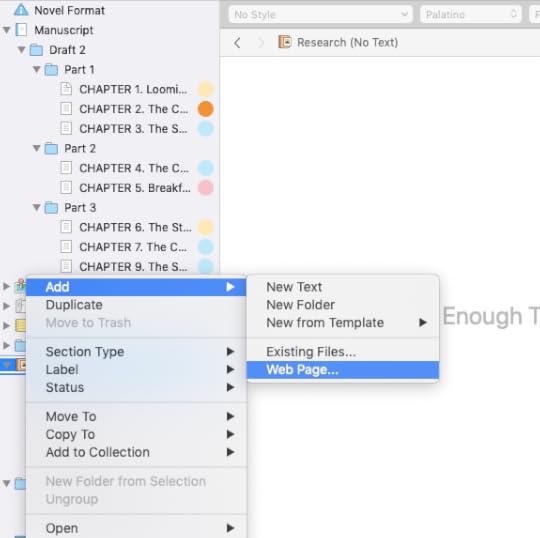
We’re continuing the #52WeeksOfScrivener series today by talking about how to embed websites.
Back before I learned this little trick, I used to create file folders full of bookmarks in my browser to store links to websites I found useful. That worked okay, but we all know how easy it is to get distracted by the Internet. The more directly I can get to my research, the less chance I have to get derailed.
How to Embed Websites
When you find a website you think you may want to reference again, simply copy the url. Then, in your binder, right click on the “Research” folder to get a pop-up menu -> Add -> Web Page.

In the pop-up window, simple add a title for the link and hit OK.
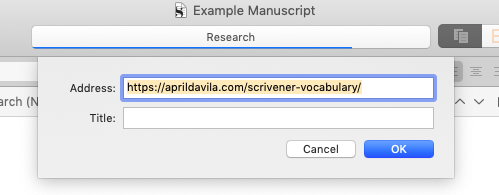
In the past (that is, before Mac OS Mojave 10.14.4) this process would give you a page, in your research file, that essentially duplicated the website in Scrivener, so you never had to go to your web browser at all. But since the OS update, what you get is this:

From what I understand, Scrivener is working on a fix that will make the website embed function work like it used to. Can’t come soon enough for me (I loved being able to reproduce websites in my research folder). But for now, you can just click on the link at the bottom of the page (see it in blue there under the Failed To Load alert?) So… still pretty useful.
And there’s more…
Set Internal References
Any time I’m working in a section where I might need the info in that embeded website, I can drag and drop the link to the notes section of the inspector.

You can also embed a link in the line of your prose, for super fast reference. When you do, it will appear as an underlined bit of text (just like a website hyperlink) like this:

The only trick here is that if you click on that link, the window will automatically open the website reference in place of what you’re working on. If you’re okay with that, then go forth. But if not, go to Preferences –> Behaviors -> Document Links to get this window.

Using that first drop down menu you can change your preferences so that when you click an embeded link, you get either 1) a little pop-up window with the embed content (called a “Quick Reference Panel”) or 2) have your writing screen automatically split into two, displaying your reference material next to the window that you’re writing in. This would be the “Other Editor” option my screen is set to.
Play around with it a little and see what works for you. I will be sure to update this post as soon as I learn that Scrivener has fixed that pesky little OS 10.14.4 bug.
Next Week
Next Monday we’ll talk more about the Research folder and all the wonderful things we can store in there. Stay tuned, follow on Twitter with #52WeeksOfScrivener, or sign up for my newsletter to get a weekly digest of all my posts.
October 18, 2019
California Chocolates

 This post is part of an extended series I’m writing about California.
This post is part of an extended series I’m writing about California. You can find out more on my Why California page.
Building on the tradition established by San Francisco-based industry giants Ghirardelli and Guittard in the 1800s, small boutique chocolatiers have popped up all over Northern California in recent years, serving up delectable bites and grabbing headlines.
The new names in chocolate (including Scharffen Berger, XOX Truffles Inc., and Joseph Schmidt Confections) are winning national acclaim in the chocolate world using unusual ingredients such as soymilk and roses. And it’s not just the critics that are taking notice.
A tourist trade has risen up around chocolate from Monterey to Sonoma. Chocolate tours generally include local history, chocolate production trivia and of course, samples, but the event not to be missed is the San Francisco International Chocolate Salon.
For a small entrance fee, visitors wander the 50,000 square foot pavilion at Fort Mason, sampling the best truffles, fudge, and creams that the region’s chocolatiers have to offer.
It may sound gluttonous, but leave it to Northern Californians to make the sweet life good for you – a 2003 UC Davis study discovered that chocolate is rich in flavonoids, the heart-healthy compounds found in many fruits and vegetables. So go ahead, indulge.
October 16, 2019
10 Years Blogging


This week marks my tenth year writing posts for this blog. Dang. 10 years blogging and not a single hiatus. I never thought I’d keep it up so long, but then, when I started blogging 10 YEARS AGO, I thought I’d have, like, three books published by now. Ha. Little baby writer-me. So naive.
Memory Lane
There was that time, after the birth of my second born, when I lined up a few awesome guest posts, like this gem from Janet Fitch, wherein she gives readers 22 tips for writing under the influence of small children.
And what about this one, the sixth post I ever wrote for this blog, back in 2009, about a meeting I took with this super fancy agent (who would end up becoming MY agent in 2018).
Or what about that time, six years ago, when I almost gave up on my novel because I was so sick of working on it I literally thought I would vomit when I opened the file.
Ah… good times.
Moving Ahead
If you follow along, you know I’ve been blogging quite a bit as of late. I’ve got the 52 Weeks of Scrivener posts that go out on Mondays. Grammar tips on Tuesdays. I take Wednesdays to rant a little and/or share what I’m learning about writing and publishing as I go along. And on Fridays I’m posting bits of California trivia that I’ve collected over the years. It’s a pretty full calendar, actually.
And I love it. I love blogging. It’s such a great way to connect with fellow writers and readers. And I find that writing about writing really helps to solidify the lessons I’ve learned through trial and error. I wouldn’t change a thing.
In fact, after I wrap up the 52 Weeks of Scrivener, I think I’m going to bring back the weekly Nerd Word posts. Those were always such fun to put together.
So stay tuned, dear readers… there’s much more in store.
October 15, 2019
Writing Tip Tuesday: Passive Voice
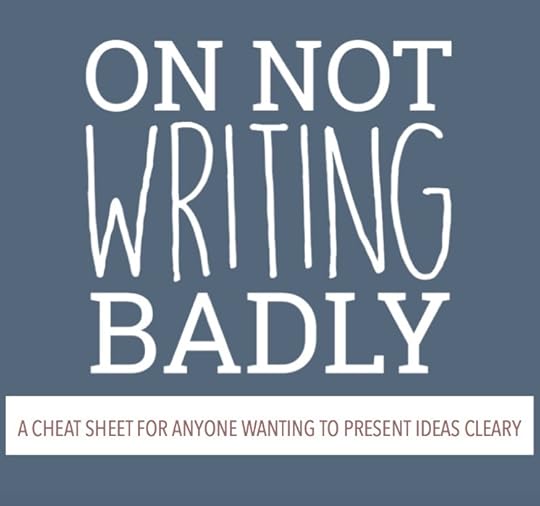
 Welcome to Writing Tip Tuesday, the Passive Voice edition. This is the eleventh in a series of posts pulled from my free guide “On Not Writing Badly.” You can download the whole thing by filling out this form, or, if you’d rather not subscribe to my email list, you can simply check back here over the next several Tuesdays for a regular dose of word nerdery.
Welcome to Writing Tip Tuesday, the Passive Voice edition. This is the eleventh in a series of posts pulled from my free guide “On Not Writing Badly.” You can download the whole thing by filling out this form, or, if you’d rather not subscribe to my email list, you can simply check back here over the next several Tuesdays for a regular dose of word nerdery.
Passive Voice
Basic sentence structure puts the subject of your sentence up front, with the verb following close after. The object of the sentence generally comes later.
Example: The dog (subject) barked (verb) at the boy (object).
In a sentence that uses active voice, the subject is doing the action. Generally speaking, active voice is preferred.
Example: I (subject) am holding (verb) the pen (object).
In a sentence that uses passive voice, the object is moved to the position of subject.
Example: The pen (object) is being held (verb) by me (subject).
Passive voice can be wordy and awkward, which is why it is generally frowned upon, but there are times when it is the better choice, as it serves to remove subjectivity.
Example: The pollution was found to be extensive. (Given the scientific topic and the need to remain impartial, this sentence is probably fine.)
Example: The holding of the pen was being carried out by me. (Terrible.)
Example: The finding of the pollution that was extensive was carried out by the researchers. (Terrible.)
Notice that in each of the examples of passive voice, the word “by” is needed or could be easily added. If you can easily add “by _____” to the end of a sentence, it is probably passive. You can have a little fun with this and add “by zombies,” or “by Donald Trump.”
Example: The knife is being held by Donald Trump.
The frighting image conjured by either option should help you remember to rearrange in favor of active voice.
October 14, 2019
How to Use the Scrivener Word Frequency Function

We’re continuing the #52WeeksOfScrivener series today by talking about the the Word Frequency Function.
I can get a little analytical with my writing. It’s the tech nerd in me. So you can imagine my excitement when I found an online word frequency analyzer a few years back. I loved being able to break my story into data and look for interesting trends. The only bummer was that I had to cut and paste my entire story into a text box on a website. Call me paranoid, but I just don’t like the idea of inserting my unfinished work into the Internet.
And now I don’t have to, because I just discovered the Scrivener word frequency analyzer. Oh, joy of nerdy joys.
How to Use It
If you’re on a Mac, simply highlight the text you want to analyze. (Yes, I’m using some fake Latin text. Like I said, I hate putting my unfinished writing out on the web.) Then go to Project -> Statistics.

(From what I’ve heard, PCs have a slightly different setup. If you have any trouble, simply click the Help menu item and type in “statistics.” That should point you in the right direction. Then maybe share a screen grab?)
You’ll get a pop-up window that looks something like this:

You may need to click the triangle in front of “Word Frequency” to unfold the data. Click on the column heading where it says “count” to sort words by frequency. Personally I like high to low.
At the top you will see words like “to” and “a.” There’s not much insight there, but scroll down a bit and things get a little more interesting.
Do Some Sleuthing
The draft I analyzed here is about 250 pages long (and yes, most of it is English). According to the analyzer, I used the word “were” more than once a page. There’s definitely room for improvement there. I also used the word “could” an awful lot. To me, this is a red flag that I’m still figuring things out on the page. I tend to use “could” when I’m not sure what my characters are doing. So in my editing, I can use the Find function to locate all those instances of “could” and see if maybe I need to dig a little deeper on my character development.
Then I scroll through looking for weak verbs. The word “see” jumps out with a frequency of 98. Again, in a draft of about 250 pages, that’s a lot of seeing. I bet I could find a better word to describe what my characters are doing for most of those. Maybe they’re peering, or spying, or understanding instead of just seeing.
I used the word “very” 51 times. Ug. That’s 51 instances of needing a better word. Guaranteed.
Don’t Obsess Over Word Frequency
It’s easy to get caught up in this kind of thing, so tread lightly.
While the data can be illuminating, you don’t need to address every word, wondering about the meaning of its frequency in your story. Simply scroll through looking for anything odd. If you have about 300 pages in your story, scroll to see what words come up about 300 times. Are they words that really should appear on pretty much every page? If not, you’ve got some work to do.
Have you used the word frequency counter? Did you find anything that surprised you?
Next Week…
Next Monday we will talk about how to embed websites into Scrivener so you never have to go hunting for your research. Stay tuned, follow on Twitter with #52WeeksOfScrivener, or sign up for my newsletter to get a weekly digest of all my posts.
October 11, 2019
Abandoned Bunkers


North of the Golden Gate, in the hills and wetlands stretching up along the coast, is a spattering of abandoned bunkers and secret tunnels dating back to 1893.
It was the end of the 19th century when William Endicott, the Secretary of War under President Cleveland, began a large-scale modernization of the country’s coastal defenses.
The Endicott Period, as it came to be known, was signified by small, well-dispersed bunkers, outfitted with large defensive artillery. Though they are now abandoned, gratified and sometimes forgotten in the underbrush of the Marin Headlands, these bunkers were San Francisco Bay’s main defense system for more than fifty years.
During WWII the guns and ammunition were relocated to support the war efforts abroad, and the bunkers never again saw active duty. When the land was transformed from a military space to a public space, the bunkers were boarded up, but not all visitors were deterred.
In the summer of 2011, local officials learned that locals had been sneaking into the abandoned subterranean structures for recreation. Before resealing the ventilation-shaft-turned-entryway they discovered graffiti dating all the way back to Nixon’s presidency.
October 9, 2019
Avoiding Reviews: A Pledge


My book doesn’t come out for four moths and eighteen days (but who’s counting, right?) and I’m already feeling tortured by reviews.
The Stars
Here’s what happened. I opened Goodreads to see if any of my advanced readers had left their reviews yet. I saw that I had three reviews and scrolled down. There were two 5-star reviews and one 3-star.
The 5-star review (which actually was the same review counted twice for some reason) left a blurb with some (lovely) thoughts on the book. The 3-star review had nothing. Nothing. Just the 3-stars. I clicked on her name. I don’t know her. I don’t even know how she got a copy of the book.
I started obsessing. Should I call my publisher and ask if they supplied the ARC to this reviewer? But then I imagined that conversation:
Me (whining): but she gave it three stars…
Publisher: we sent her a copy in exchange for an honest review.
Me: but I want more stars…
Publisher: ummm….
Needless to say I didn’t make that phone call. But I could not stop thinking about it. And this is when I realized why so many authors say they don’t read reviews.
A Better Understanding
Honestly, I never really understood that. I always thought reading reviews would be, at the very least, interesting. But now I understand. It’s not that the actual act of reading reviews is difficult, it’s the headspace those reviews take up in the days and weeks that follow. They create doubt and insecurity.
It’s hard to not care what people think of your creative work.
But what I realized is that I’m entering a part of this process where I no longer have any control. The book is done. It is what it is. My work is complete and it’s silly to obsess over something I cannot control.
My job is just to keep writing. And if this experience has taught me anything, it’s that I have trouble being creative when I’m thinking about stars.
So I am hereby making a pledge to henceforth avoid reading any and all reviews.
They’re not for me anyway.
I’ll circle back to this come March, a month or so after my pub date, and see how I’m doing with my pledge. Wish me luck.



